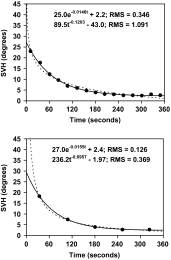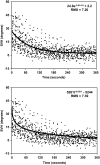On the time course of short-term forgetting: a human experimental model for the sense of balance
- PMID: 26834858
- PMCID: PMC4722133
- DOI: 10.1007/s11571-015-9362-0
On the time course of short-term forgetting: a human experimental model for the sense of balance
Abstract
The primary aim of this study was to establish whether the decline of the memory of an angular displacement, detected by the semicircular canals, is best characterized by an exponential function or by a power function. In 27 subjects a conflict was created between the semicircular canals and the graviceptive systems. Subjects were seated, facing forwards, in the gondola of a large centrifuge. The centrifuge was accelerated from stationary to 2.5Gz. While the swing out of the gondola (66°) during acceleration constitutes a frontal plane angular-displacement stimulus to the semicircular canals, the graviceptive systems persistently signal that the subject is upright. During 6 min at 2.5Gz the perceived head and body position was recorded; in darkness the subject repeatedly adjusted the orientation of a luminous line so that it appeared to be horizontal. Acceleration of the centrifuge induced a sensation of tilt which declined with time in a characteristic way. A three-parameter exponential function (Y = Ae(-bt) + C) and a power function (Y = At(-b) + C) were fitted to the data points. The inter-individual variability was considerable. In the vast majority of cases, however, the exponential function provided a better fit (in terms of RMS error) than the power function. The mean exponential function was: y = 27.8e(-0.018t) + 0.5°, where t is time in seconds. Findings are discussed with connection to possible underlying neural mechanisms; in particular, the head-direction system and short-term potentiation and persistent action potential firing in the hippocampus are considered.
Keywords: Short-term memory; Spatial memory; Spatial orientation; Vestibular memory; Vestibular psychophysics.
Figures




Similar articles
-
Human vestibular memory studied via measurement of the subjective horizontal during gondola centrifugation.Neurobiol Learn Mem. 2003 Jul;80(1):1-10. doi: 10.1016/s1074-7427(03)00041-8. Neurobiol Learn Mem. 2003. PMID: 12737929
-
Vestibular Stimulus and Perceived Roll Tilt During Coordinated Turns in Aircraft and Gondola Centrifuge.Aerosp Med Hum Perform. 2016 May;87(5):454-63. doi: 10.3357/AMHP.4491.2016. Aerosp Med Hum Perform. 2016. PMID: 27099084
-
Pitch-Plane Angular Displacement Perception During Helicopter Flight and Gondola Centrifugation.Aerosp Med Hum Perform. 2016;87(10):852-861. doi: 10.3357/AMHP.4627.2016. Aerosp Med Hum Perform. 2016. PMID: 27662347
-
Perspectives for the comprehensive examination of semicircular canal and otolith function.Biol Sci Space. 2001 Dec;15(4):393-400. doi: 10.2187/bss.15.393. Biol Sci Space. 2001. PMID: 12101365 Review.
-
Perception of Verticality and Vestibular Disorders of Balance and Falls.Front Neurol. 2019 Apr 3;10:172. doi: 10.3389/fneur.2019.00172. eCollection 2019. Front Neurol. 2019. PMID: 31001184 Free PMC article. Review.
Cited by
-
Spatial orientation during gondola centrifugation with subjects upright versus supine: Evidence for Gestalt psychological mechanisms in vestibular perception.J Vestib Res. 2021;31(6):451-467. doi: 10.3233/VES-201527. J Vestib Res. 2021. PMID: 33646191 Free PMC article.
-
The informational entropy endowed in cortical oscillations.Cogn Neurodyn. 2018 Oct;12(5):501-507. doi: 10.1007/s11571-018-9491-3. Epub 2018 Jun 18. Cogn Neurodyn. 2018. PMID: 30250628 Free PMC article.
-
Visual measures of perceived roll tilt in pilots during coordinated flight and gondola centrifugation.J Vestib Res. 2023;33(1):1-19. doi: 10.3233/VES-220016. J Vestib Res. 2023. PMID: 36442173 Free PMC article.
-
Factors of significance for the ability of fighter pilots to visually indicate the magnitude of roll tilt during simulated turns in a centrifuge.Perception. 2024 Feb;53(2):75-92. doi: 10.1177/03010066231209847. Epub 2023 Nov 9. Perception. 2024. PMID: 37946509 Free PMC article.
References
-
- Anderson JR, Schooler LJ. Reflections of the environment in memory. Psychol Sci. 1991;2(6):396–408. doi: 10.1111/j.1467-9280.1991.tb00174.x. - DOI
LinkOut - more resources
Full Text Sources
Other Literature Sources

